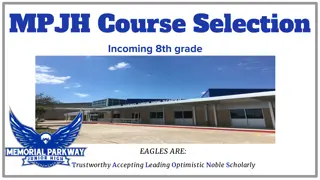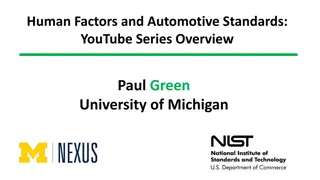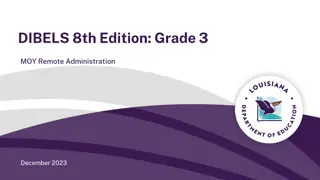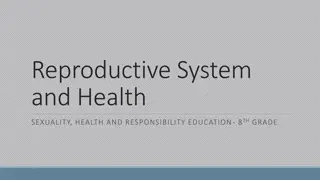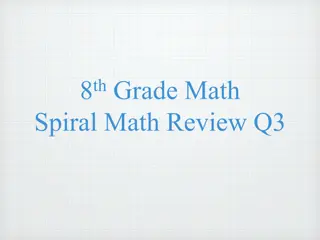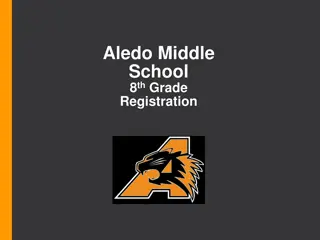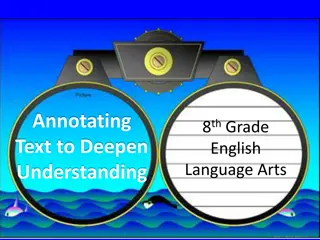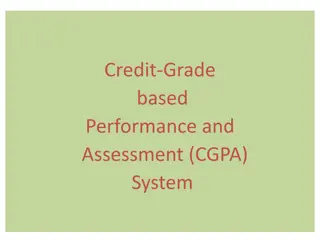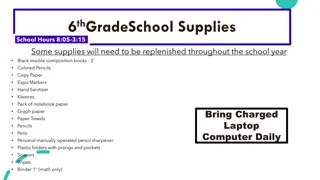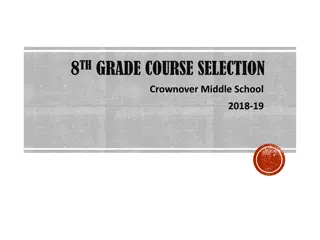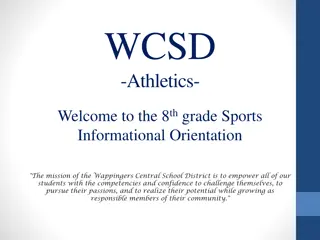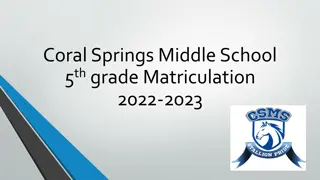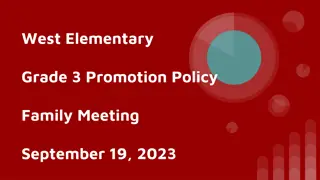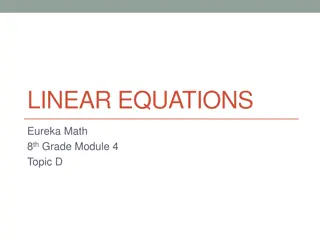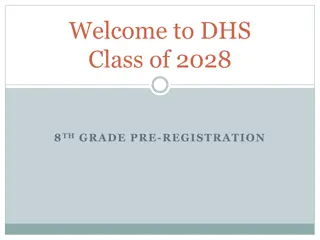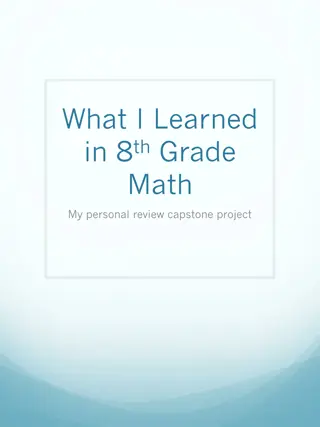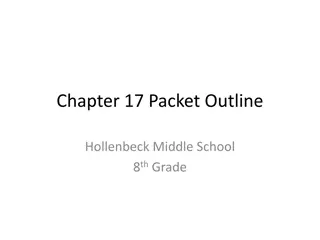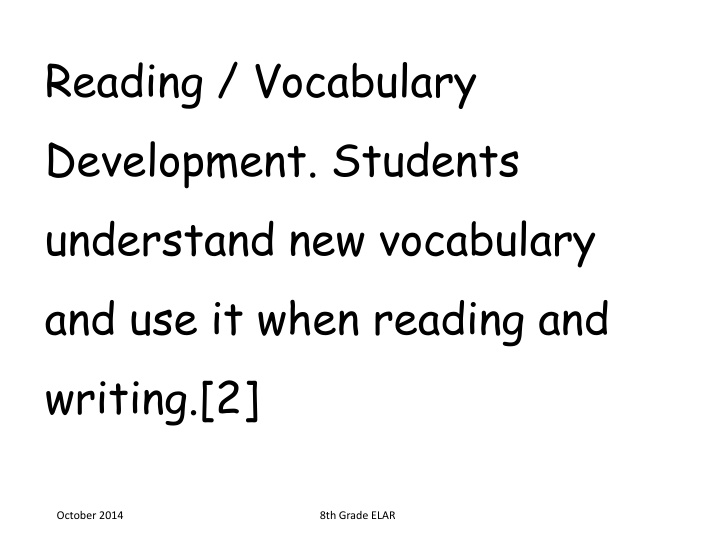
Enhancing Reading and Vocabulary Skills in 8th Grade ELAR Curriculum
Improve reading and vocabulary skills in 8th Grade ELAR by understanding new vocabulary, using context clues, completing analogies, and analyzing literary texts to identify themes and genres. Students will also learn to determine the meanings of academic English words and use resources like dictionaries and thesauruses effectively.
Download Presentation

Please find below an Image/Link to download the presentation.
The content on the website is provided AS IS for your information and personal use only. It may not be sold, licensed, or shared on other websites without obtaining consent from the author. If you encounter any issues during the download, it is possible that the publisher has removed the file from their server.
You are allowed to download the files provided on this website for personal or commercial use, subject to the condition that they are used lawfully. All files are the property of their respective owners.
The content on the website is provided AS IS for your information and personal use only. It may not be sold, licensed, or shared on other websites without obtaining consent from the author.
E N D
Presentation Transcript
Reading / Vocabulary Development. Students understand new vocabulary and use it when reading and writing.[2] October 2014 8th Grade ELAR
determine the meaning of grade-level academic English words derived from Latin, Greek, or other linguistic roots and affixes.[2A] October 2014 8th Grade ELAR
use context (within a sentence and in larger sections of text) to determine or clarify the meaning of unfamiliar or ambiguous words or words with novel meanings.[2B] October 2014 8th Grade ELAR
complete analogies that describe a function or its description (e.g., pen:paper as chalk: ______ or soft:kitten as hard: ______).[2C] October 2014 8th Grade ELAR
identify common words or word parts from other languages that are used in written English (e.g., phenomenon, charisma, chorus, pass , flora, fauna).[2D] October 2014 8th Grade ELAR
use a dictionary, a glossary, or a thesaurus (printed or electronic) to determine the meanings, syllabication, pronunciations, alternate word choices, and parts of speech of words.[2E] October 2014 8th Grade ELAR
Comprehension of Literary Text / Theme and Genre. Students analyze, make inferences and draw conclusions about theme and genre in different cultural, historical, and contemporary contexts and provide evidence from the text to support their understanding.[3] October 2014 8th Grade ELAR
analyze literary works that share similar themes across cultures.[3A] October 2014 8th Grade ELAR
compare and contrast the similarities and differences in mythologies from various cultures (e.g., ideas of afterlife, roles and characteristics of deities, purposes of myths).[3B] October 2014 8th Grade ELAR
explain how the values and beliefs of particular characters are affected by the historical and cultural setting of the literary work.[3C] October 2014 8th Grade ELAR
Comprehension of Literary Text / Poetry. Students understand, make inferences and draw conclusions about the structure and elements of poetry and provide evidence from text to support their understanding.[4] October 2014 8th Grade ELAR
compare and contrast the relationship between the purpose and characteristics of different poetic forms (e.g., epic poetry, lyric poetry).[4A] October 2014 8th Grade ELAR
Comprehension of Literary Text / Drama. Students understand, make inferences and draw conclusions about the structure and elements of drama and provide evidence from text to support their understanding.[5] October 2014 8th Grade ELAR
analyze how different playwrights characterize their protagonists and antagonists through the dialogue and staging of their plays.[5A] October 2014 8th Grade ELAR
Comprehension of Literary Text / Fiction. Students understand, make inferences and draw conclusions about the structure and elements of fiction and provide evidence from text to support their understanding.[6] October 2014 8th Grade ELAR
analyze linear plot developments (e.g., conflict, rising action, falling action, resolution, subplots) to determine whether and how conflicts are resolved.[6A] October 2014 8th Grade ELAR
analyze how the central characters' qualities influence the theme of a fictional work and resolution of the central conflict.[6B] October 2014 8th Grade ELAR
analyze different forms of point of view, including limited versus omniscient, subjective versus objective.[6C] October 2014 8th Grade ELAR
Comprehension of Literary Text / Literary Nonfiction. Students understand, make inferences and draw conclusions about the varied structural patterns and features of literary nonfiction and provide evidence from text to support their understanding.[7] October 2014 8th Grade ELAR
analyze passages in well-known speeches for the author's use of literary devices and word and phrase choice (e.g., aphorisms, epigraphs) to appeal to the audience.[7A] October 2014 8th Grade ELAR
Comprehension of Literary Text / Sensory Language. Students understand, make inferences and draw conclusions about how an author's sensory language creates imagery in literary text and provide evidence from text to support their understanding.[8] October 2014 8th Grade ELAR
explain the effect of similes and extended metaphors in literary text.[8A] October 2014 8th Grade ELAR
Comprehension of Informational Text / Culture and History. Students analyze, make inferences and draw conclusions about the author's purpose in cultural, historical, and contemporary contexts and provide evidence from the text to support their understanding.[9] October 2014 8th Grade ELAR
analyze works written on the same topic and compare how the authors achieved similar or different purposes.[9A] October 2014 8th Grade ELAR
Comprehension of Informational Text / Expository Text. Students analyze, make inferences and draw conclusions about expository text and provide evidence from text to support their understanding.[10] October 2014 8th Grade ELAR
summarize the main ideas, supporting details, and relationships among ideas in text succinctly in ways that maintain meaning and logical order.[10A] October 2014 8th Grade ELAR
distinguish factual claims from commonplace assertions and opinions and evaluate inferences from their logic in text.[10B] October 2014 8th Grade ELAR
make subtle inferences and draw complex conclusions about the ideas in text and their organizational patterns.[10C] October 2014 8th Grade ELAR
synthesize and make logical connections between ideas within a text and across two or three texts representing similar or different genres and support those findings with textual evidence.[10D] October 2014 8th Grade ELAR
Comprehension of Informational Text / Persuasive Text. Students analyze, make inferences and draw conclusions about persuasive text and provide evidence from text to support their analysis.[11] October 2014 8th Grade ELAR
compare and contrast persuasive texts that reached different conclusions about the same issue and explain how the authors reached their conclusions through analyzing the evidence each presents.[11A] October 2014 8th Grade ELAR
analyze the use of such rhetorical and logical fallacies as loaded terms, caricatures, leading questions, false assumptions, and incorrect premises in persuasive texts.[11B] October 2014 8th Grade ELAR
Comprehension of Informational Text / Procedural Texts. Students understand how to glean and use information in procedural texts and documents.[12] October 2014 8th Grade ELAR
analyze text for missing or extraneous information in multi-step directions or legends for diagrams.[12A] October 2014 8th Grade ELAR
evaluate graphics for their clarity in communicating meaning or achieving a specific purpose.[12B] October 2014 8th Grade ELAR
Reading / Media Literacy. Students use comprehension skills to analyze how words, images, graphics, and sounds work together in various forms to impact meaning. Students will continue to apply earlier standards with greater depth in increasingly more complex text. [13] October 2014 8th Grade ELAR
evaluate the role of media in focusing attention on events and informing opinion on issues.[13A] October 2014 8th Grade ELAR
interpret how visual and sound techniques (e.g., special effects, camera angles, lighting, music) influence the message.[13B] October 2014 8th Grade ELAR
evaluate various techniques used to create a point of view in media and the impact on audience.[13C] October 2014 8th Grade ELAR
assess the correct level of formality and tone for successful participation in various digital media.[13D] October 2014 8th Grade ELAR
Writing / Literary Texts. Students write literary texts to express their ideas and feelings about real or imagined people, events, and ideas.[15] October 2014 8th Grade ELAR
write an imaginative story that[15A] October 2014 8th Grade ELAR
write an imaginative story that sustains reader interest.[15Ai] October 2014 8th Grade ELAR
write an imaginative story that includes well-paced action and an engaging story line.[15Aii] October 2014 8th Grade ELAR
write an imaginative story that creates a specific, believable setting through the use of sensory details.[15Aiii] October 2014 8th Grade ELAR
write an imaginative story that develops interesting characters.[15Aiv] October 2014 8th Grade ELAR
write an imaginative story that uses a range of literary strategies and devices to enhance the style and tone.[15Av] October 2014 8th Grade ELAR
write a poem using[15B] October 2014 8th Grade ELAR
write a poem using poetic techniques (e.g., rhyme scheme, meter).[15Bi] October 2014 8th Grade ELAR
write a poem using figurative language (e.g., personification, idioms, hyperbole).[15Bii] October 2014 8th Grade ELAR


